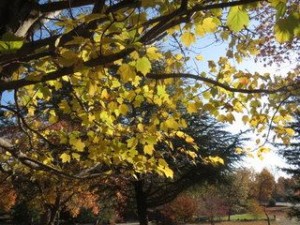Author: Heather Hacking hhacking@chicoer.com @HeatherHacking on Twitter
Increasingly, I’m faced with what must be a widespread garden geek’s dilemma: How do we go about our business in the middle of the drought?
As we shift into the new season, I would normally be gushing about planting bulbs and shopping for something to bloom through the winter.

Yet, should we be planting anything at all?
I called Kay Perkins, a Master Gardener for Butte County. She told me pretty much what I didn’t want to hear.
Master Gardeners attend a boat-load of classes so they can give gardeners advice. (You can call them at 538-7201 on Wednesdays from 9 a.m.-noon and Thursday 1-4 p.m.).
If you ask about growing tips, the Master Gardeners will still gladly give you info.
Yet, if you ask a direct question about planting during drought, the answer is that its best not to bother.
“In general, our guideline is that in a drought the best we can do is triage,” Kay said.
If you’re using water in the yard, save it for trees and shrubs to allow them to survive, she said.
Another suggestion is to tear out the lawn.
Good drought timing
This would be the year for it. After all, if we aren’t planting new things we have nothing better to do.
Plus if the yard looks too good, people might walk by and give you a scornful look.
Lawns are nice when you’re a kid and have time to lay on your back looking up at the sky.
But unless you’re training for the Olympic croquet team, most lawns are water-hogging, time-absorbing pieces of green that no longer serve a useful purpose in modern, dry California society.
If you decide to change your entire front-yard environment, here’s some steps to follow.
First, cut the lawn as short as possible, Kay said. Next, layer the grass with newspaper or cardboard, which is biodegradeable.
Have a friend help, because it might be difficult to spread out the material. A friend will also stop you from driving to the garden center and buying two six-packs of perennials.
Next, pile a bunch of mulch on top of the paper material.
Kay has had good luck sweet-talking landscapers to drop off a truckload of mulch. Landscapers don’t want to pay to take the chipped wood and leaves to the compost facility.
Kay advised getting to know the outdoor workers a bit, and ask if the load includes anything noxious like privet or poison oak.
Don’t be offended if the landscaper says no. Kay said more people are taking out their lawns and need mulch, and more people know to ask landscapers for their wood scraps.
Leaves will work as well, at least four inches deep.
The city of Chico curb-side leaf pickup program begins Nov. 3. If you’re a hard-worker you might be able to scoop up all the leaves your neighbors have left out to dry.
Or you could wheel your green waste can down the block and ask your neighbors to fill it up. Have children? When they’re bad punish them by forced collection of leaves for your project.
Even after a few months of being suffocated by mulch, Bermuda and nut grass (http://goo.gl/jfE0Lo) are deep-rooted and may survive even the harshest of torture. However, these tenacious weeds should be far less of a problem than when you started, Kay said.
If you’re not ready to get rid of the entire lawn, consider living with less.
The folks at the water company say installing a water-saving showerhead or toilet means less water use for years to come.
This can be the same with a lawn. If you whittle yourself down to just a small green space, you’ll save water well into the future.
Next spring, if good rains return, you can break up the uniform color of mulch by digging holes into the rich soil and planting individual, drought-tolerant plants.
You can send in your dry-time garden rants, or green thumb drought topic suggestions to @HeatherHacking on Twitter and Facebook.
